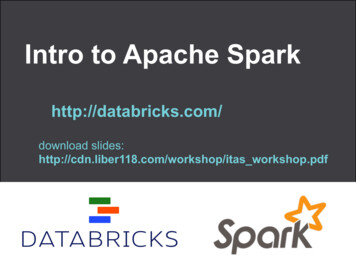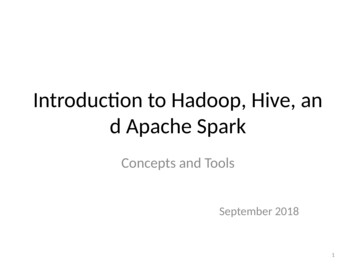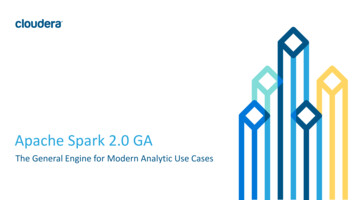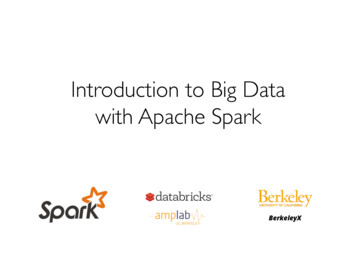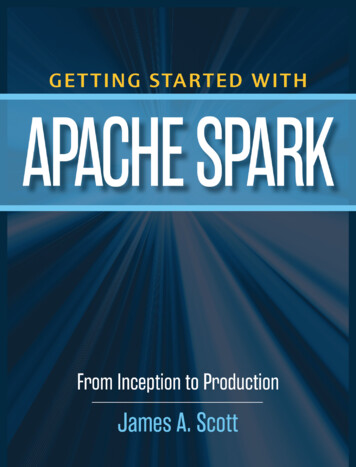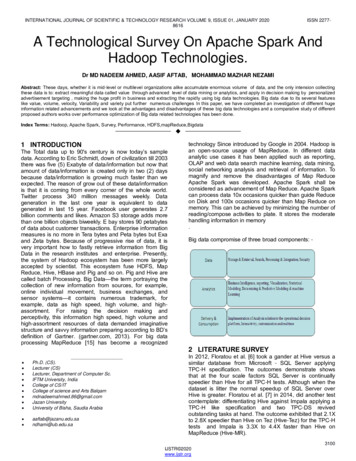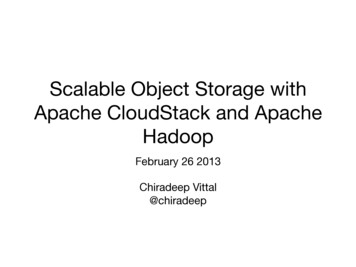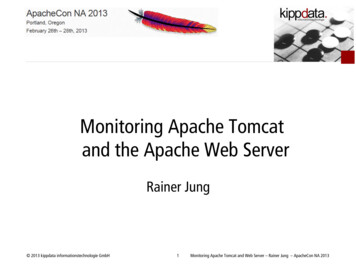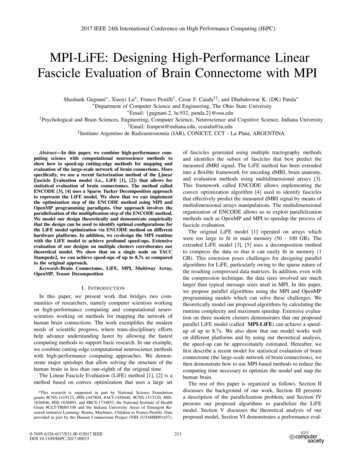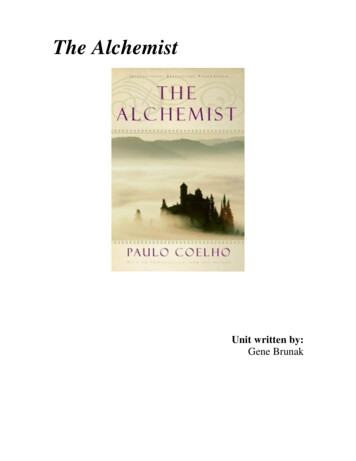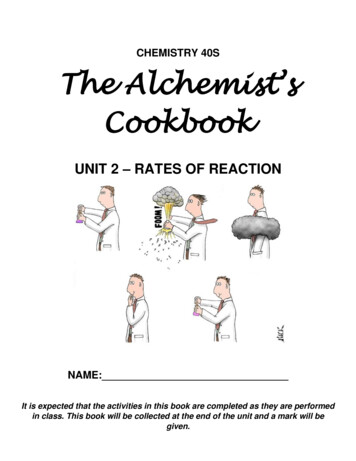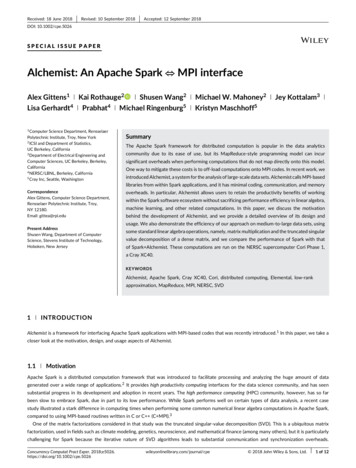
Transcription
Received: 18 June 2018Revised: 10 September 2018Accepted: 12 September 2018DOI: 10.1002/cpe.5026SPECIAL ISSUE PAPERAlchemist: An Apache Spark MPI interfaceAlex Gittens1 Kai Rothauge2Shusen Wang2Lisa Gerhardt4 Prabhat4 Michael Ringenburg5Michael W. Mahoney2Kristyn Maschhoff5Jey Kottalam31 ComputerScience Department, RensselaerPolytechnic Institute, Troy, New York2 ICSI and Department of Statistics,UC Berkeley, California3 Department of Electrical Engineering andComputer Sciences, UC Berkeley, Berkeley,California4 NERSC/LBNL, Berkeley, California5 Cray Inc, Seattle, WashingtonSummaryThe Apache Spark framework for distributed computation is popular in the data analyticscommunity due to its ease of use, but its MapReduce-style programming model can incursignificant overheads when performing computations that do not map directly onto this model.One way to mitigate these costs is to off-load computations onto MPI codes. In recent work, weintroduced Alchemist, a system for the analysis of large-scale data sets. Alchemist calls MPI-basedlibraries from within Spark applications, and it has minimal coding, communication, and memoryCorrespondenceAlex Gittens, Computer Science Department,Rensselaer Polytechnic Institute, Troy,NY 12180.Email: gittea@rpi.eduoverheads. In particular, Alchemist allows users to retain the productivity benefits of workingwithin the Spark software ecosystem without sacrificing performance efficiency in linear algebra,machine learning, and other related computations. In this paper, we discuss the motivationbehind the development of Alchemist, and we provide a detailed overview of its design andusage. We also demonstrate the efficiency of our approach on medium-to-large data sets, usingPresent AddressShusen Wang, Department of ComputerScience, Stevens Institute of Technology,Hoboken, New Jerseysome standard linear algebra operations, namely, matrix multiplication and the truncated singularvalue decomposition of a dense matrix, and we compare the performance of Spark with thatof Spark Alchemist. These computations are run on the NERSC supercomputer Cori Phase 1,a Cray XC40.KEYWORDSAlchemist, Apache Spark, Cray XC40, Cori, distributed computing, Elemental, low-rankapproximation, MapReduce, MPI, NERSC, SVD1INTRODUCTIONAlchemist is a framework for interfacing Apache Spark applications with MPI-based codes that was recently introduced.1 In this paper, we take acloser look at the motivation, design, and usage aspects of Alchemist.1.1MotivationApache Spark is a distributed computation framework that was introduced to facilitate processing and analyzing the huge amount of datagenerated over a wide range of applications.2 It provides high productivity computing interfaces for the data science community, and has seensubstantial progress in its development and adoption in recent years. The high performance computing (HPC) community, however, has so farbeen slow to embrace Spark, due in part to its low performance. While Spark performs well on certain types of data analysis, a recent casestudy illustrated a stark difference in computing times when performing some common numerical linear algebra computations in Apache Spark,compared to using MPI-based routines written in C or C (C MPI).3One of the matrix factorizations considered in that study was the truncated singular-value decomposition (SVD). This is a ubiquitous matrixfactorization, used in fields such as climate modeling, genetics, neuroscience, and mathematical finance (among many others), but it is particularlychallenging for Spark because the iterative nature of SVD algorithms leads to substantial communication and synchronization overheads.Concurrency Computat Pract Exper. linelibrary.com/journal/cpe 2018 John Wiley & Sons, Ltd.1 of 12
2 of 12GITTENS ET AL.The results of an extensive and detailed evaluation (see figures 5 and 6 in the work of Gittens et al3 ) show not only that Spark is more than anorder of magnitude slower than the equivalent procedure implemented using C MPI for datasets in the 10 TB size range, but also that Spark'soverheads in fact dominate and anti-scale, ie, the overheads take up an increasing amount of the computational workload relative to the actualmatrix factorization calculations as the number of nodes used increases.3Spark follows a data parallel bulk synchronous programming model, where a single driver process manages the execution of the submittedapplications, which are then carried out on executor processes. The sole distributed data type for Spark is the Resilient Distributed Dataset(RDD), an immutable distributed array that is partitioned across the executors. Each application submitted to a Spark cluster is converted to acomputational graph on the driver, and this graph is then compiled into a sequence of stages, collections of computational tasks that are executedsimultaneously on each partition of the RDDs. The tasks in each stage run on the executor that holds the relevant partition, with inter-processcommunication happening only between stages. Spark is implemented on the Java Virtual Machine (JVM) and uses TCP/IP for inter-processcommunication.This simple structure makes Spark an easily-learned framework, but it negatively impacts its performance. In particular, the constraints on theinter-process communication patterns, the lack of mutable and more flexible distributed datatypes, and the centralized scheduling of tasks, alllead to unacceptably large overheads in linear algebraic applications such as those commonly used in machine learning.3This is the motivation for the development of Alchemist.4 Alchemist links to MPI-based libraries dynamically, and it supplies a user-friendlyand efficient interface for transferring the required data from Spark executors across the network to the MPI processes, running the MPI code,and then returning the results back to the Spark application. Alchemist thus enables users to work within the high productivity context of Spark,while offloading performance sensitive computations onto high performance MPI codes. This approach combines Spark's strengths, such as itsfast development cycle, the large collection of data analysis routines that can be used before and after the linear algebra computations, andSpark's I/O routines, while bypassing many of the inefficiencies in the Spark workflow related to its significant overheads.The NERSC supercomputer Cori Phase 1, a Cray XC40 located at Lawrence Berkeley National Laboratory in Berkeley, California, has beenused extensively in the development of Alchemist.1.2Related workThere are previous attempts to address Spark's performance issues by either directly interfacing Spark with MPI or reimplementing Spark-likeframeworks with MPI-style communication primitives.The Smart system falls in the latter category, as a C reimplementation of a MapReduce-like framework built on MPI.5 The subsequentSmart-MLlib project interfaces Spark with Smart and provides a partial reimplementation of Spark's MLlib library.6 Smart-MLlib facilitates datatransfer between the Spark executors and MPI processes by writing and reading from single intermediary files. This system has not been shownto be scalable and appears to no longer be under development.The Spark-MPI project adds an MPI layer on top of Spark's standard driver-executor model.7 In Spark-MPI codes, as in standard Spark codes,data is distributed as RDDs and the driver is responsible for scheduling and launching computational stages, but within stages, the executors cancommunicate with each other using MPI primitives. While promising, the project is still in its early stages, and it is unclear if or how it is possibleto call existing MPI-based libraries from within Spark.The MPIgnite framework similarly extends the Spark programming model by providing access to MPI peer-to-peer and collective communicationprimitives.8 This project is also in its early stages, and no performance results were provided. Importantly, both Spark-MPI and MPIgnitedeliberately diverge from the MapReduce programming model of Spark, so codes written for these systems are not portable to standard Sparkinstallations.The project closest in spirit to our approach (in that it facilitates invoking existing MPI-based libraries from Spark) is Spark MPI.9 Under thisframework, data is serialized and transferred from Spark to an existing MPI-based library using RAM disks, and the output is written to disk usingthe fault-tolerant HDFS format, which is read by Spark and loaded back into an RDD. Spark MPI offers a simple API and supports sparse dataformats. Furthermore, it is clear that existing codebases can be updated to call more efficient implementations of computational primitives inSpark MPI with essentially line edits. However, the reported overheads of this system are significant when compared to the compute time, andthe data sets used were relatively small, so it is not yet clear if this approach is scalable or appropriate for large-scale (in particular, dense) data sets.Alchemist differs in important ways from these previous systems, most notably in the following ways. Alchemist does not change the Spark programming model: Each call to an MPI routine constitutes a separate stage of a Spark job. In particular,existing codebases can be line-edited to replace inefficient computations with calls to efficient MPI-based implementations. Alchemist uses sockets to transfer information between Spark and MPI. This avoids incurring large slow-downs due to disk IO, and it similarlyavoids the prohibitive memory overheads that can arise when RAM disk methods are used to transfer large data sets. Alchemist is explicitly engineered for the transfer of large, dense matrices, which are worst-case use cases for some other Spark-MPI bridges. Alchemist has a flexible and extensible interface: any MPI code that allows the user to specify the MPI communicator can be wrapped. Userscan either write their performance critical codes in MPI and wrap them with Alchemist, or find pre-written codes and wrap them with Alchemist.
GITTENS ET AL.3 of 12Outline of the Alchemist framework. One or more Spark applications can each call one or more MPI-based libraries to help acceleratesome numerical computations. Alchemist acts as an interface between the applications and the libraries, with data between Alchemist and theapplications transmitted using TCP/IP sockets. Alchemist loads the libraries dynamically at runtimeFIGURE 11.3OutlineThe rest of this paper is organized as follows. In Section 2, we give an extensive discussion of the design and implementation of Alchemist,as well as the motivation for some of the design choices that have been made. In Section 3, we discuss some points related to the usage ofAlchemist, with special emphasis on how to use it on Cori. The results of some illustrative experiments are shown in Section 4 (we encourageinterested readers to see our original paper, which introduced Alchemist1 for complementary experiments, with an emphasis on relevant datascience applications, including truncated PCA/SVD computations on even larger data sets of sizes up to 17.6 TB.) In Section 5, we conclude withsome final thoughts and future work.2DESIGNThis section describes the design and implementation of Alchemist. The Alchemist framework consists of the core Alchemist system and twointerfaces, ie, an Alchemist-Client Interface (ACI) and an Alchemist-Library Interface (ALI). See Figure 1 for an illustration. Spark applicationsimport the ACI, which provides functions to interact with Alchemist and to gain access to the MPI routines exposed through Alchemist. Atpresent, all communication from the Spark application to Alchemist occurs through the ACI via TCP/IP sockets.Alchemist, in turn, calls the desired MPI-based library through the associated ALI. Every MPI-based library has an associated ALI that consistsof a thin wrapper around the MPI code whose functionality is to be exposed. The ALIs import their associated MPI libraries and need to becompiled as dynamic libraries. Alchemist then loads every ALI that is required by some Spark application dynamically at runtime.Alchemist connects these two interfaces by providing a structure for data interchange. In the remainder of this section, we give a more detaileddiscussion of the inner workings of the Alchemist framework.2.1The Alchemist-Client interfaceAlchemist has a server-based architecture, with one or more Spark applications being able to connect to it concurrently, assuming sufficientAlchemist workers are available. Each Spark application has to import the ACI and start an AlchemistContext object in order to establish aconnection with Alchemist (more details on this are presented in the next section).We broadly distinguish between two different kinds of input and output parameters, viz, those that require distributed data structures fortheir storage and those that do not. In the former category, we have, for instance, distributed dense matrices of floating point numbers. Thesestructures must be transmitted between the Spark executors and Alchemist workers. In the latter category, we include parameters such asstep sizes, maximum iteration counts, cut-off values, etc. Such parameters are transferred easily from the application to Alchemist by usingserialization, and they require communication only between the Spark and Alchemist drivers.The critical functionality of Alchemist is an efficient implementation of communication for distributed data structures. In particular, in order toserve as a bridge, it must support sending distributed input data sets from the application to the library, as well as returning distributed outputdata sets (if any) from the library to the application. The design goals of the Alchemist system include making the transmission of these distributeddata sets easy to use, efficient, and scalable.Generally, there are three approaches that could be used to transmit the data. File I/O. Writing the distributed data set to a distributed file format on one side, and then reading it on the other side, has the benefit of beingeasy to use, and if HDFS is used, fault-tolerant. This approach will generally tend to be very slow when working with standard HDDs, although ithas been argued that using an array of SSDs as the storage platform would alleviate this problem. However, SSDs are an expensive investment,and thus, there is generally insufficient availability on supercomputers or in cluster centers to be useful to users with large data sets. In-memory intermediary. A second option is to use an intermediate form of storage of the data in memory that can be read by both sides. Thiscould be done using shared memory (commonly available on Linux systems), or in-memory distributed storage systems such as the open-sourceApache Ignite or Alluxio. Unfortunately, we already need two copies of the data, one in the application, and the other in Alchemist, and since
4 of 12FIGURE 2GITTENS ET AL.An illustration of the Alchemist framework. See Section 2.4 for an explanationwe are considering very large data sets, having a third copy of the data in memory is undesirable. Nevertheless, this may be an attractiveoption under certain circumstances. Data transfer from the Spark processes directly to the MPI processes using sockets. This third option is an in-memory procedure and istherefore very fast, while not requiring an additional copy of the data set. This is therefore the most practical option for our purposes.Alchemist and the ACI open multiple TCP/IP sockets between the Spark executors and Alchemist workers for communication, as well as onesocket connection between the two driver processes. The communication is asynchronous, allowing not only multiple Spark drivers to connectto the Alchemist driver concurrently, but also accomodating the case where each Alchemist worker receives data from several Spark executors.See Figure 2 for an illustrative example and Section 2.4 for the associated discussion. Network communication in Alchemist is implemented usingthe Boost.Asio library.10RDDs store their contents in rows. When transferring the data from a partition to a recipient Alchemist worker, the Spark executor sends eachrow of the RDD partitions to the recipient worker by transmitting the row as sequences of bytes. The received data is then recast to floating pointnumbers by the worker. Conversely, the transmission of matrices from the Alchemist workers to the application is done in a similar row-wisefashion. In the applications we consider in this paper, the distributed data sets are dense matrices of floating point numbers, which means thatAlchemist currently sends and receives data using Spark's IndexedRowMatrix RDD data structure.As the Alchemist workers receive the data from the Spark executors, they store it in a distributed matrix using the Elemental library, which isdescribed next.2.2The Elemental libraryAlchemist makes use of Elemental,11 an open-source software package for distributed-memory dense and sparse linear algebra and optimization.Elemental provides a convenient interface for handling distributed matrices with its DistMatrix class, which is what Alchemist uses to storethe data transmitted from the RDDs. As an added benefit, Elemental provides a large suite of sequential and distributed-memory linear algebraoperations that can be used to easily manipulate the distributed matrices. Copying data from distributed data sets in Spark to distributed matricesin Elemental requires some changes in the layout of the data, a task that is handled by Alchemist. The Elemental distributed matrix then servesas input to the C MPI routines in the MPI-based libraries that Alchemist calls.Although Alchemist at present only directly supports MPI-based libraries that make use of Elemental, it is nonetheless possible to use MPI-basedlibraries built on top of other distributed linear algebra packages, for instance ScaLAPACK and PLAPACK. However, at present, this requires theuse of wrapper functions to convert Elemental's distributed matrices to the appropriate format, and this will incur additional overhead, includingpotentially an additional copy of the data in memory. Support for certain other distributed linear algebra packages will be added in the future.2.3The Alchemist-Library interfaceAfter starting the AlchemistContext object, the Spark application should let Alchemist know which libraries it wishes to use, as well as thelocation of the associated ALIs for those libraries. An ALI is a shared object (ie, a dynamic library) written in C/C that Alchemist can link todynamically at runtime, assuming that there is a Spark application that wants to use it.
GITTENS ET AL.5 of 12ALIs are necessary because Alchemist itself does not have direct knowledge of the MPI-based libraries. Each ALI imports its MPI-based libraryand provides a generic interface that Alchemist uses to provide it with the name of the routine in the library, and to send and receive input andoutput parameters to and from the routine in a pre-specified format.The basic workflow is as follows. The Alchemist workers receive the distributed data and store it in one or more Elemental DistMatrices. The Alchemist driver receives all the necessary metadata and non-distributed input parameters from the Spark application, including the nameof the library and the routine in it that the application wants to use. Alchemist calls the ALI and passes on the name of the routine, the non-distributed input parameters, and pointers to the DistMatrices. The ALI then calls the routine in the MPI-based library with the supplied input parameters in a format appropriate for that specific library, andit returns the result in a format appropriate for Alchemist once the computations have completed. Alchemist passes the results to the Spark application via the ACI similarly to before, ie, distributed matrices between the workers andnon-distributed data between the drivers.The use of an interface that is dynamically resolved at runtime keeps Alchemist flexible by avoiding the need to maintain a wrapper functioninside Alchemist for every function in each MPI-based library that an application may want to call. Such a centralized system would incur asignificant amount of work for each additional library, would not give users the option to add libraries in a portable manner, and would impose asevere maintenance and support burden.2.4An illustrative exampleFigure 2 shows an example of the Alchemist framework at work. Alchemist is running on ten processes, one of which is the driver. SparkApplication 1 has four processes, three of which are executors. The Spark driver connects to the Alchemist driver using the ACI and requestsfour of the available Alchemist workers, as well as access to the MPI-based libraries A and C. Alchemist loads the libraries and gives the Sparkapplication access to four of its workers (group I in the diagram), to which the ACI in each Spark process then connects.Metadata and non-distributed data are sent between the drivers, and distributed data is sent from the Spark workers to Alchemist's workergroup I, where the data is stored as an Elemental distributed matrix. Each worker in group I calls the required functions in libraries A and Cthrough the associated ALIs and lets the libraries do the necessary computations.In the meantime, a second Spark application, with just one executor, connects to Alchemist and requests access to three Alchemist workernodes and library C. Alchemist grants access to three of its remaining workers (group II) and the Spark worker connects to them. After transferringall the data, the desired functions in library C are called. After completion, the output of all the computations is sent from the Alchemist workers tothe connected Spark executors. In this example, no application made use of library B, so there was no reason for Alchemist to dynamically link to it.The current architecture used by Alchemist, where the Spark application and the core Alchemist system run on separate groups of nodes, isdue to Spark and Alchemist presently not being able to run on the same nodes on Cori. The specific reasons for this are not yet clear and futurereleases of Alchemist may not be subject to this requirement.3USING ALCHEMISTAlchemist is designed to be easily deployable, flexible, and easy to use. The only required import in a Spark application is the ACI, and the ACIworks with standard installations of Spark.In this section, we discuss various aspects of using Alchemist, ie, its dependencies and how to start it are discussed in Sections 3.1 and 3.2,respectively; the API is presented in Section 3.3; library wrappers are discussed in Section 3.4; and the basic procedure for adding a newMPI-based library to the system is illustrated in Section 3.5.3.1DependenciesAlchemist is written in C 11 and currently has the following dependencies: Any common implementation of MPI 3.0 or higher,12 such as recent versions of Open MPI13 or MPICH14 (or its variants); The Boost.Asio library10 for communicating with the ACI over sockets, as mentioned above; The Elemental library11 discussed previously for storing the distributed data and providing some linear algebra operations; and The spdlog library,15 a fast, header only, thread-safe C logging library for capturing Alchemist's output.In addition, each MPI-based library (and its dependencies) that the Spark application wants to use should be installed on the system.
6 of 123.2GITTENS ET AL.Starting AlchemistThe procedure for starting Alchemist varies slightly depending on the system on which one is working, but the overall approach remains the sameand is summarized in the following steps.1. The user starts Alchemist and specifies the number of MPI processes. Similar to Spark, one Alchemist process acts as the driver and all othersare worker processes.2. The Alchemist driver provides the IP address of the node and port number that it is running on, and the Spark driver then connects to thedriver via the ACI.3. The Spark driver can then request a user-defined number of Alchemist workers. Alchemist allocates the workers to the application (assuminga sufficient number of workers is available) and sends their IP addresses and the ports on which they are running to the ACI. The ACI thenfacilitates the TCP/IP socket connections of the Spark workers with the allocated Alchemist workers.Communication between the drivers and workers on either side can begin once all the sockets have been opened.The Alchemist driver process receives control commands from the Spark driver, and it relays the relevant information to the worker processes.This communication is enabled by a dedicated MPI communicator for each connected Spark application, where the communicator includes theAlchemist driver and all workers allocated to that application.On Cori Phase 1, Alchemist is started by running the script Cori-start-alchemist.sh, which needs to be run after a batch or interactivejob has been launched. The script takes the number of nodes that Alchemist needs to run on and the number of cores per Alchemist worker(and driver). The remainder of the nodes allocated to the Cori job are then available for use by the Spark applications. The driver outputs itshostname, IP address, and port number to disk, where it can be read by the Spark driver's ACI.Allowing flexibility in the number of nodes running Spark and Alchemist processes enables more resources to be allocated to Spark for jobswhere it will do significant computing, and more resources can be allotted to Alchemist otherwise. We note that the number of MPI processestends to be greater than the number of Spark executors, because MPI jobs typically benefit from much higher levels of parallelism than Spark.3.3The APIThe API of Alchemist, as far as the user is concerned, is restricted to the interaction of the Spark application with the ACI. The required syntax toget started simply involves importing the ACI, creating a new AlchemistContext object, and loading one or more libraries. If sc is an existingSparkContext instance, a sample code looks as follows:import alchemist.{Alchemist, AlMatrix}// other code here .val ac new Alchemist.AlchemistContext(sc, numWorkers)// maybe other code here .ac.registerLibrary(ALIlibAName, ALIlibALocation).Here, the hypothetical ALI ALIlibA for the hypothetical MPI library libA has name ALIlibAName and is located at ALIlibALocation on thefile system.Alchemist uses matrix handles in the form of AlMatrix objects, which act as proxies for the distributed data sets stored on Alchemist. Aftertransmitting the data in an RDD to Alchemist, Alchemist returns an AlMatrix object, which contains a unique ID identifying the matrix toAlchemist, as well as other information such as the dimensions of the matrix.Similarly, for every output matrix that an MPI-based routine creates, an output matrix returns an AlMatrix object to the application. TheseAlMatrix objects allow the user to pass the distributed matrices within Alchemist from one library function to the next. Only when the userexplicitly converts this object into an RDD will the data in the matrix be sent between Alchemist to Spark. In this way the amount of datatransferred between Alchemist and Spark is minimized.If A is an IndexedRowMatrix in the application, and the function condest in libA estimates the condition number of its input matrix, thenthe following sample code shows how to call the routine from Spark:val alA AlMatrix(A)val output ac.run(ALIlibAName, “condest”, alA).The ac.run function takes a variable length argument list, where the first argument is the name of the MPI-based library to use, the secondis the name of the routine in the library that is being called, and the rest are the input parameters (in the above example, there was just oneinput, AlA). The output parameters are stored in the parameters list output. See the documentation of Rothauge and Gittens4 for morecomplicated examples.
GITTENS ET AL.7 of 12After all the MPI computations have been completed and the output AlMatrix objects have been retrieved to IndexedRowMatrix objects,the user can stop the AlchemistContext instance usingac.stop()similarly to how an instance of SparkContext is stopped.Note that the API may be altered in future releases.3.4Using library wrappersThe API can be simplified even more by creating library wrappers. For instance, to create a library wrapper for ALIlibA from the previoussubsection, we create a new Scala package, libA say. Each routine in libA that will be called can then be given its own object that takes the inputparameters as arguments. For the condest routine, for instance, we could havepackage alchemist.libAimport alchemist.{Alchemist, AlMatrix}// other code here .object CondEst {def apply(alA: AlMatrix): Float {ac.run(“libA”, “condest”, alA)}}.In this case, the sample Spark application above would then be modified as follows:import alchemist.{Alchemist, AlMatrix}import alchemist.libA.CondEst// other code here .val ac new Alchemist.AlchemistContext(sc, numWorkers)ac.registerLibrary(“libA”, ALIlibALocation)// maybe other code here .val alA AlMatrix(A)val condNum CondEst(alA).As mentioned above, library wrappers for MPI-based libraries provide a method for giving the user a simple API for using the libraries, even if thelibraries themselves have a complicated syntax, and one benefit of this approach is that one can easily mimic the API used by, for instance, MLlib.This way, one would have to only make minimal changes to existing code when switching from MLlib for some computation to an MPI-basedlibrary called through Alchemist.3.5Adding a new libraryAdding an MPI-based library to Alchemist is fairly straightforward, requiring only the implementation of the ALI for that particular library. Asmen
The Alchemist framework consists of the core Alchemist system and two interfaces, ie, an Alchemist-Client Interface (ACI) and an Alchemist-Library Interface (ALI). See Figure 1 for an illustration. Spark application s import the ACI, which provides functions to interact with Alchemist a
